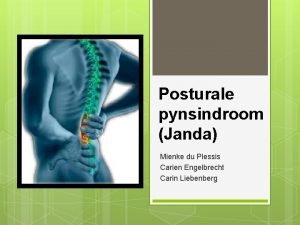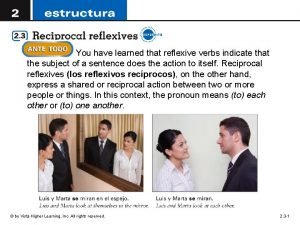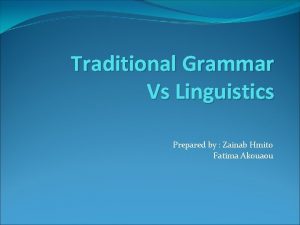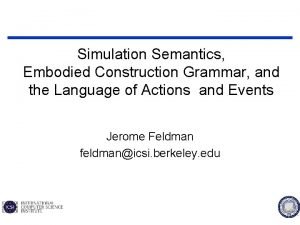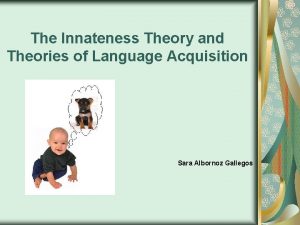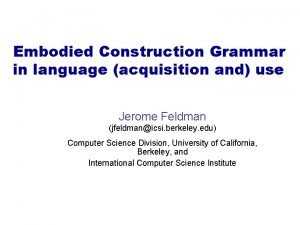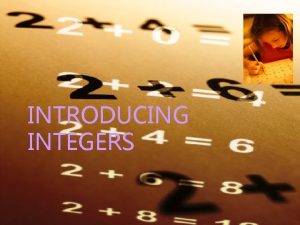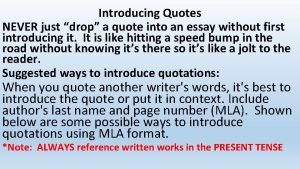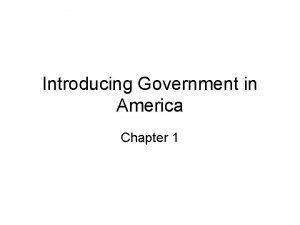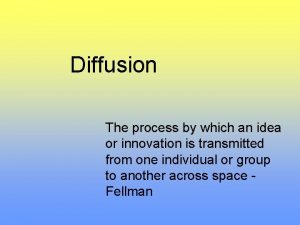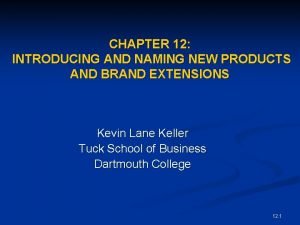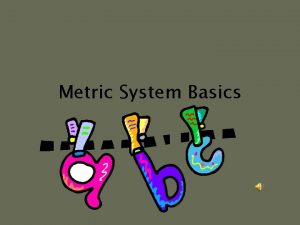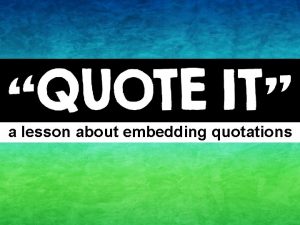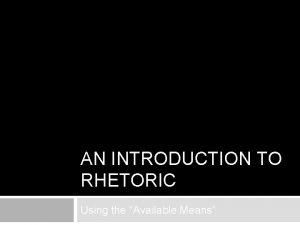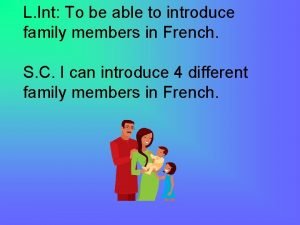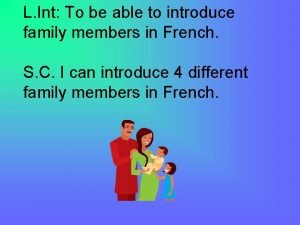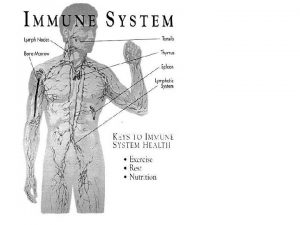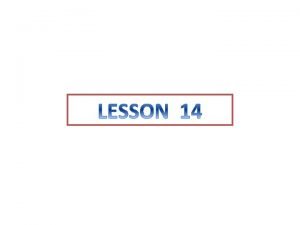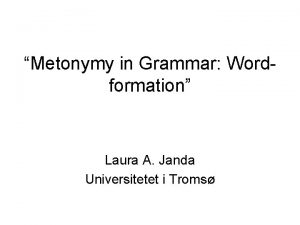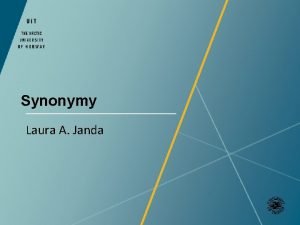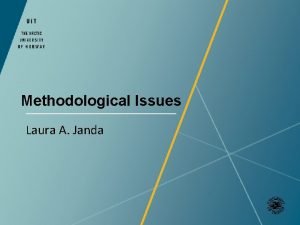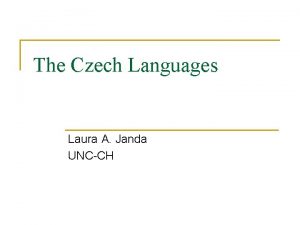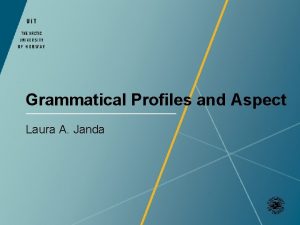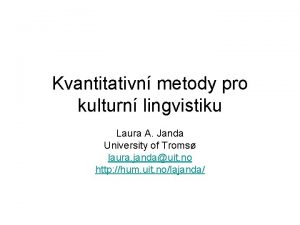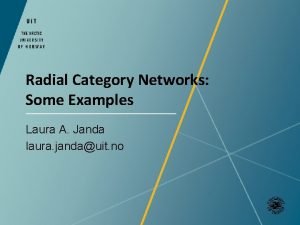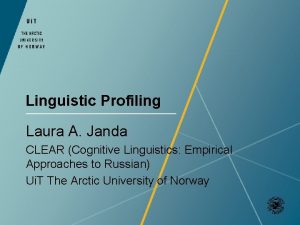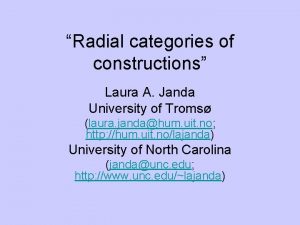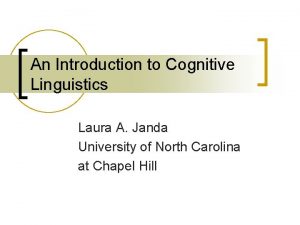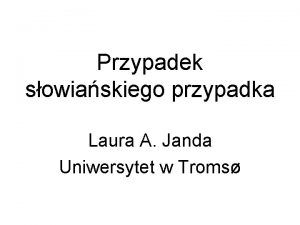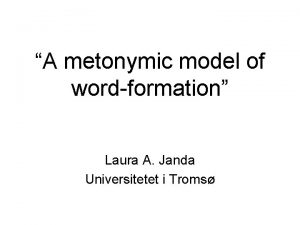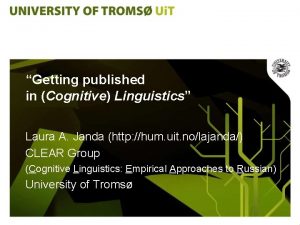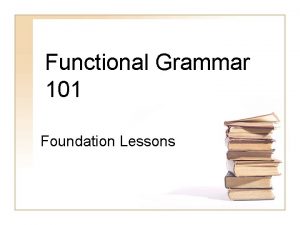Introducing Construction Grammar Laura A Janda Overview 1



































































- Slides: 67

Introducing Construction Grammar Laura A. Janda

Overview 1. Why Construction Grammar? 2. What is Construction Grammar? 3. Who Kissed Who? and other problems 4. Corpus investigation of Constructions 5. Experimental investigation of Constructions 6. Constructicons for learners 2

1. Why Construction Grammar? Who Kissed Who? …and other problems you can’t solve with rules Generative grammar presumes that • syntax is separate from lexicon • grammatical structure is governed by rules • grammatical constructions are compositional But there a lot of questions that you can’t answer from this perspective: • The boy was kissed by the girl. Who kissed who? Why is this hard? • An accident waiting to happen • Have a great time and watch your step! • Death by constructions: Kick the bucket and Curiosity killed the cat • Give the Red Cross money, but don’t Donate the Red Cross money • What’s with after? I arrived/looked after John • Czech věřící: how believing became a characteristic 3

1. Why Construction Grammar? Who Kissed Who? …and other problems you can’t solve with rules Generative grammar presumes that In section 3 we will go through all of these problems for learners • syntax is separate from lexicon and linguists and show they are accounted for in • grammatical structure is governed by rules Construction Grammar… • grammatical constructions are compositional …but first we should look at what Construction Grammar is. But there a lot of questions that you can’t answer from this perspective: • The boy was kissed by the girl. Who kissed who? Why is this hard? • An accident waiting to happen • Have a great time and watch your step! • Death by constructions: Kick the bucket and Curiosity killed the cat • Give the Red Cross money, but don’t Donate the Red Cross money • What’s with after? I arrived/looked after John • Czech věřící: how believing became a characteristic 4

2. What is Construction Grammar? Before we answer this question, we need to understand – What is Cognitive Linguistics? We will answer this question with reference to: 1. Basic assumptions about language 2. Relationship between language and cognition 3. Structure of linguistic categories And with reference to William Croft’s Radical Construction Grammar 2001 Adele Goldberg’s Constructions at Work 2006 5

Cognitive Linguistics: Assumptions Minimal Assumption: language can be accounted for in terms of general cognitive strategies • no autonomous language faculty • no strict division between grammar and lexicon • no a priori universals Usage-Based: generalizations emerge from language data • no strict division between langue and parole • no underlying forms Meaning is Central: holds for all language phenomena • no semantically empty forms • meaning is grounded in human experience • metaphor and metonymy play a major role in grammar

Cognitive Linguistics: Language & Cognition • Linguistic cognition has no special status – All linguistic phenomena can be explained via general cognitive mechanisms • Language is not divided into discrete levels or modules – phonology, morphology, syntax and lexicon form a continuous phenomenon – primary motive for all linguistic phenomena is meaning

Cognitive Linguistics: Categories • Linguistic categories are cognitive categories and have the same structure – Established through research in psychology and neurobiology – Radial category centered on a prototype with extensions

Furniture for sitting

If you speak English, your chair category looks like this: rocking chair lawn chair high chair armchair wheel chair

If you speak Norwegian, your stol category looks like this: gyngestol solseng barnestol lenestol rullestol

If you speak Czech, you have overlapping židle and křeslo categories: houpácí židle/křeslo lehátko židlička židle křeslo invalidní vozík/křeslo


The take-home lesson about chairs: • Categorization isn’t “out there” in the world, reality can be categorized in different ways • Different languages can use different strategies for categorizing experience • This is true for their grammatical constructions too

William Croft Radical Construction Grammar 2001 • Syntax is semantically motivated • Linguistic categories (“adjective”, “passive”, “dative”) are language-specific • No strict universals, but some tendencies • Idiomaticity is a cline • Constructions are the basic units; pairings of form and meaning

Adele Goldberg’s Cognitive Construction Grammar (Constructions at Work 2006) • Language is the aggregate network of constructions • Language is learned on the basis of input and general cognitive mechanisms • Storage and grammatical “rules” (generalizations) overlap, coexist and cooperate • Idioms are not special, no clear boundary between idioms and grammar

Properties of Constructions are form-meaning pairings available at all levels of linguistic complexity • 17 In addition: a) language is a network of related constructions b) meaning is often not entirely compositional c) meaning can be complex d) form a continuum from idiomatic to schematic e) can have relationships to specific words f) emerge as “chunks” g) can evolve over time We will address each of these properties in connection with the seven “problems” we previously identified

3. Who Kissed Who? and other problems a) The boy was kissed by the girl. Who kissed who? b) An accident waiting to happen c) Have a great time and watch your step! d) Death by constructions: Kick the bucket and Curiosity killed the cat e) Give the Red Cross money, but don’t Donate the Red Cross money f) What’s with after? I arrived/looked after John g) Czech věřící: how believing became a characteristic 18 a) Relationships among constructions b) Holistic meaning of constructions c) Polysemy of constructions d) Idiomaticity vs. schematicity of constructions e) Relationships between specific words and constructions f) Chunking g) Historical drift

a) The boy was kissed by the girl and Relationships among constructions A B Who kissed who? Why do learners choose A instead of B? Because: ✔� they know that constructions are related to each other ✔�they know that word order is important in English ✘they assume that this is related to the transitive NP VP NP construction 19

Another family of related constructions in English: Subject Auxiliary Inversion (SAI) Yes/No questions: WH-questions: Counterfactual conditionals: Initial negative adverbs: Wishes/Curses: Exclamatives: Comparatives(inversion optional): Negative conjunct: Positive rejoinder: Did he go? What did he do? Had she left on time, she’d be here now. Not until today did he take a break. May you live a good life! Boy, are you tired or what? ! He has read more articles than have his classmates Never had she seen such a beautiful sight. So was I. Goldberg (2006) argues that the SAI constructions exhibit a unified function 20

The SAI family of constructions 21

Notice that sorting SAI from non-SAI is very important for learners In most instances, only SAI is allowed: (a)Not until today did he take a break. (b) *Not until today he did take a break. When non-SAI is possible, SAI constructions have the opposite meaning: (a) For no money would she leave. (b) For no money she would leave. 22

SAI Characteristics • • Prototypical sentence: declarative, positive assertion with predicate-focus information, independent In SAI the auxiliary is in the non-canonical position, which tells us the polarity is not canonical either (canonical would be positive) • SAI is different: – Negative or non-positive framing – Non-declarative or non-assertive speech acts – Narrow-focus or sentence-focus – Dependent on other clauses • A single SAI construction doesn’t necessarily have all of these characteristics at once, but will have some of them; NON-POSITIVE framing dominates Take-home lesson: Constructions can be taught in families, making the task more coherent, less chaotic

b) An accident waiting to happen and Holistic meaning of constructions • Constructions often have a holistic, noncompositional meaning. A(n) NP waiting to happen: there is nothing in the parts of this construction that would indicate something negative But there is a strong connection with negative events: – accident – disaster – crisis And this connection influences the interpretation of neutral words like event • • • When a construction forces an interpretation of a component, we call that “coercion” 24

Coercion by constructions These constructions might look innocent: Ditransitive (NP V NP NP): Pat gave Sally the book Caused-Motion (NP V NP PP): Sam wiped the crumbs off the table Resultative (NP V NP AP): Mary wiped the table clean all over (+ DP): John has food all over his face way-construction: The soldiers marched their way across Russia 25

Coercion by constructions These constructions might look innocent: Ditransitive (NP V NP NP): Pat gave Sally the book Caused-Motion (NP V NP PP): Sam wiped the crumbs off the table Resultative (NP V NP AP): Mary wiped the table clean all over (+ DP): John has food all over his face way-construction: The soldiers marched their way across Russia These constructions can coerce words inserted into their slots to have unusual meanings 26

Ditransitive (NP V NP NP): Pat gave Sally the book Gave is inherently ditransitive. Its frame includes a receiver. The Ditransitive construction can force receivers upon verbs that do not usually have them: Pat kicked Sally the ball Pat baked Sally a cake Well, that’s not so amazing, but check out the rest of these constructions…. 27

Caused-Motion (NP V NP PP): Sam wiped the crumbs off the table This construction can make intransitive verbs transitive Lucy sneezed the napkin off the table The audience booed the comedian off the stage 28

Resultative (NP V NP AP): Mary wiped the table clean This construction can coerce verbs to take direct objects that they would not otherwise take: The tourists drank the pub dry Hank talked himself blue in the face This construction can also coerce adjectives (Boas 2011): Ed hammered the metal flat > Ed hammered the metal safe See this context: The door of Ed’s old Dodge had a piece of metal sticking out. When getting out of the car, Ed had cut himself on the metal and had to go to the hospital to get stitches. The next day, Ed hammered the metal safe. 29

all over (+ DP): John has food all over his face This construction can coerce count nouns to be interpreted as mass nouns (“grinding”): There’s cat all over the road You’ve got rabbit all over your windshield 30

way-construction: The soldiers marched their way across Russia Not only does this construction make intransitive verbs transitive, it can also coerce other verbs to express motion: Lucy laughed her way out of the room. Robin fought her way through the bureaucracy. Martin bungled his way out of business 31

c) Have a great time and watch your step! and Polysemy of constructions The English Imperative construction an uninflected verb form at the beginning usually lacks overt subject may include a postverbal element (NP, PP) functions as a directive speech act expresses a particular illocutionary force 32

c) Have a great time and watch your step! and Polysemy of constructions A single construction can have a network of related meanings. The English Imperative construction has these meanings (Stefanowitsch 2003): Command: Open the door! Request: Please pass the salt Instruction: Melt the butter in the saucepan Permission: Sure, go ahead Warning: Watch your step! Good wishes: Have a great birthday! 33

c) Have a great time and watch your step! and Polysemy of constructions A singlethat construction can have a network are of related in Notice while these meanings related meanings. a network, individual meanings can be very The English Imperative construction has these different from each other meanings (Stefanowitsch 2003): Command: Request: Instruction: Permission: Warning: Good wishes: 34 Open the door! Please pass the salt Melt the butter in the saucepan Sure, go ahead Watch your step! Have a great birthday!

d) Death by constructions: Kick the bucket and Curiosity killed the cat and Idiomaticity vs. schematicity of constructions Idiomaticity and schematicity are a continuum All constructions lie along this continuum The most schematic constructions: have open slots few restrictions The most idiomatic constructions: have fixed words have idiosyncratic syntax 35

Idiomaticity vs. schematicity continuum • NP V NP Most schematic • answer the door • the X-er the Y-er • Kick the bucket • Curiosity killed the cat • all of a sudden 36 Most idiomatic

Idiomaticity vs. schematicity continuum • NP V NP Canonical sentence schema, Most schematic The girl kissed the boy • answer the door • the X-er the Y-er • Kick the bucket • Curiosity killed the cat • all of a sudden 37 Most idiomatic

Idiomaticity vs. schematicity continuum • NP V NP slots are open, few restrictions, Most schematic largely compositional • answer the door • the X-er the Y-er • Kick the bucket • Curiosity killed the cat • all of a sudden 38 Most idiomatic

Idiomaticity vs. schematicity continuum • NP V NP • answer the door Most schematic slots are fixed, no grammatical restrictions, partially compositional • the X-er the Y-er • Kick the bucket • Curiosity killed the cat • all of a sudden 39 Most idiomatic

Idiomaticity vs. schematicity continuum • NP V NP • answer the door Most schematic follows syntactic pattern of NP V NP • the X-er the Y-er • Kick the bucket • Curiosity killed the cat • all of a sudden 40 Most idiomatic

Idiomaticity vs. schematicity continuum Most schematic • NP V NP • answer the door • the X-er the Y-er slots are open, some restrictions, idiosyncratic syntax • Kick the bucket • Curiosity killed the cat • all of a sudden 41 Most idiomatic

Idiomaticity vs. schematicity continuum Most schematic • NP V NP • answer the door • the X-er the Y-er • Kick the bucket slots are filled, few other restrictions, canonical syntax • Curiosity killed the cat • all of a sudden 42 Most idiomatic

Idiomaticity vs. schematicity continuum • NP V NP Most schematic • answer the door • the X-er the Y-er • Kick the bucket • Curiosity killed the cat • all of a sudden 43 slots are filled, absolute restrictions, canonical syntax Most idiomatic

Idiomaticity vs. schematicity continuum • NP V NP Most schematic • answer the door • the X-er the Y-er • Kick the bucket • Curiosity killed the cat • all of a sudden 44 Most idiomatic slots are filled, absolute restrictions, idiosyncratic syntax

e) Give the Red Cross money, but don’t Donate the Red Cross money and Relationships between specific words and constructions English has two constructions to express transfer from an actor to a receiver: Ditransitive: Give the Red Cross money To-Dative: Bring used clothing to the Red Cross give and bring can be used in both constructions, but they prefer the Ditransitive 45

Both meaning and experience are relevant in grammaticality of constructions (Goldberg 2011) A number of verbs appear in both the Ditransitive and To. Dative constructions: • give, tell, bring, teach, send, offer, show, read, lend etc. These verbs strongly prefer the Ditransitive (0. 04 probability on average) Some verbs have compatible meanings but occur only in the To-Dative construction: • donate, explain, whisper, transfer, entrust, repeat These verbs are not expected in Ditransitive Statistical preemption: If a speaker has heard a word only in the To-Dative, they assume it is not grammatical in the higher frequency Ditransitive 46

Both meaning and experience are relevant in grammaticality of constructions (Goldberg 2011) A number of verbs appear in both the Ditransitive and To. Dative constructions: • give, tell, bring, teach, send, offer, show, read, lend etc. These verbs strongly prefer the Ditransitive (0. 04 probability on average) Some verbs have compatible meanings but occur only in To-Dative construction: • donate, explain, whisper, transfer, entrust, repeat These verbs are not expected in Ditransitive In other words: experience trumps meaning Reasoning: Why would a person use the To-Dative all the time if the Ditransitive is available? 47

f) What’s with after? I arrived/looked after John and Chunking How do we know that in the sentence I arrived after John, after refers to time and goes with John, whereas in the sentence I looked after John, after goes with looked to modify the verb to mean ‘take care of’? This has to do with the fact that constructions are emergent structures Learners pick up repeated constructions as “chunks” and only gradually make generalizations look after is a frequent collocation; arrive after isn’t 48

A construction emerges from a fixed expression in the speech of Naomi (Dąbrowska 2000) 1; 11. 11 1; 11. 21 2; 0. 18 What doing? What’s Mommy doing? What’s donkey doing? What’s Naomi doing? What’s toy doing? What’s Mommy holding? What’s Georgie saying? What is the boy 2; 0. 26 2; 1. 19 2; 11. 17 making? 2; 11. 18 What is Andy doing? (What’s reappears later…) 49

A construction emerges from a fixed expression in the speech of Naomi (Dąbrowska 2000) 1; 11. 11 1; 11. 21 2; 0. 18 What doing? What’s Mommy doing? What’s donkey doing? What’s Naomi doing? What’s toy doing? What’s Mommy holding? What’s Georgie saying? What is the boy 2; 0. 26 2; 1. 19 2; 11. 17 making? 2; 11. 18 What is Andy doing? (What’s reappears later…) 50 fixed expression

A construction emerges from a fixed expression in the speech of Naomi (Dąbrowska 2000) 1; 11. 11 1; 11. 21 2; 0. 18 What doing? What’s Mommy doing? What’s donkey doing? NP is generalized to names What’s Naomi doing? What’s toy doing? What’s Mommy holding? What’s Georgie saying? What is the boy 2; 0. 26 2; 1. 19 2; 11. 17 making? 2; 11. 18 What is Andy doing? (What’s reappears later…) 51

A construction emerges from a fixed expression in the speech of Naomi (Dąbrowska 2000) 1; 11. 11 1; 11. 21 2; 0. 18 What doing? What’s Mommy doing? What’s donkey doing? What’s Naomi doing? What’s toy doing? What’s Mommy holding? What’s Georgie saying? What is the boy 2; 0. 26 2; 1. 19 2; 11. 17 making? 2; 11. 18 What is Andy doing? (What’s reappears later…) 52 V is generalized

A construction emerges from a fixed expression in the speech of Naomi (Dąbrowska 2000) 1; 11. 11 1; 11. 21 2; 0. 18 What doing? What’s Mommy doing? What’s donkey doing? What’s Naomi doing? What’s toy doing? What’s Mommy holding? What’s Georgie saying? What is the boy 2; 0. 26 2; 1. 19 2; 11. 17 making? 2; 11. 18 What is Andy doing? (What’s reappears later…) 53 NP generalized further What’s > What is

Long-Distance Dependencies (Dąbrowska et al. 2009) • Long-Distance Dependencies are sentences like: – Who did Pat stammer that she liked? – What does the funny old man really hope you think? • Generativist position is that they are impossible to learn from input • Corpus research shows that the vast majority of LDDs are of the type – What do you think … ? as in: – What do you think the funny old man really hopes? • In other words, What do you think … ? can be learned as a chunk • Experimental research shows that children acquire lexically specific templates (chunks) and make more abstract generalizations about constructions only later, and in some cases may continue to rely on templates even as adults 54

g) Czech věřící: how believing became a characteristic and Historical drift Fried (2015) analyzes the historical development of the present active participle in Old Czech in the direction of an adjective. Three functions are relevant: a. Predicative: (pr is el jsem) ve r i cí ‘(I came) believing’ b. Attributive: ve r i cí c love k ‘a believing person’ c. Nominalized: ve r i cí ‘a believer’ All three functions are attested in Old Czech, but the predicative function (a) became marginalized, attributive and nominalized functions came to dominate Modern Czech • Gradual shift of syntactic category from verb (participle) to adjective due to dynamic tension between word meaning and syntactic construction: verbal meaning of the word gets suppressed by the nominal syntactic constructions the participles occur in • The locus of the change is the construction, since the shift from verb to adjective cannot be understood without taking the constructions into account • Construction Grammar facilitates a precise and explicit analysis of the interaction between lexical meaning and syntactic construction and gradual change over time 55

4. Corpus investigation of Constructions We’ve already seen that corpus data can tell us about constructions: – Most frequent collocates for NP waiting to happen – Distribution of Ditransitive vs. To-Dative – LDD mostly attested as What do you think … ? Corpus data is very useful for sorting out factors at work when constructions compete 56

Corpus investigations of competing constructions In Russian there are two constructions to express that something happened in a given decade ‘in the twenties’: – with the Accusative case: v dvacatye gody – with the Locative case: v dvacatyx godax Nesset and Makarova have discovered that there has been a language change, and the accusative case is now the norm 57

Percentage of accusative case in Russian “decades construction” over time 80, 0 70, 0 60, 0 50, 0 40, 0 Perfective Imperfective 30, 0 20, 0 10, 0 58 1826 -1850 1851 -1875 1876 -1900 1901 -1925 1926 -1950 1951 -1975

Corpus investigations of competing constructions • In Russian, there are two constructions for expressing 2, 3, or 4 things modified by an adjective: – with the adjective in the genitive plural and the noun in the paucal • tri malen´kix stolika ‘three little tables’ – with the adjective in the nominative plural and the noun in the paucal • tri malen´kie stolika ‘three little tables’ • Most textbooks teach only the genitive plural construction • But Nesset and Nordrum have discovered that there is a language change going on and that gender is becoming the deciding factor, with masculine and neuter nouns preferring the genitive construction and feminine nouns preferring the accusative construction 59

Genitive vs. Nominative plural Adjectives with numerals 2, 3, 4 in Russian over time 100, 00% 90, 00% 80, 00% M N 70, 00% 60, 00% F 50, 00% 40, 00% 30, 00% 20, 00% 10, 00% 60 1825 -1849 1850 -1874 1875 -1899 1900 -1924 1925 -1949 1950 -1974 1975 -1999 2000 -2015

5. Experimental investigation of Constructions Kuznetsova and Nesset (2015) did an experiment on the factors that decide between a genitive construction and an accusative construction for a group of verbs: – slušat´sja ‘obey’, dožidat´sja ‘wait for’, bojat´sja ‘fear’, dostigat´ ‘reach’, izbegat´ ‘avoid’ Corpus data give evidence of a language change (genitive > accusative) and of significant factors relating to individuation of the direct object An experiment made it possible to sort out the contributions of various factors The experiment also showed that declension was an important factor: III declension nouns are dispreferred in the accusative construction For example, particpants avoided the accusative construction with the III declension proper name Ljubov´ (only 8% acceptance), whereas accusative is preferred for II declension names Ol´ga, Nina 61

62

6. Constructicons for learners A language is the aggregate network of constructions (Goldberg 2006) = a “constructicon” Constructicons are currently under development for English, Brazilian Portuguese, German, Japanese, Russian, and Swedish Described in forthcoming volume Constructicography. Constructicon development across languages. Benjamin Lyngfelt et al. (eds. ). John Benjamins Publishing Co. 63

Abstract from Lyngfeldt et al. “A constructicon is on the one hand a theoretical conception of language as a structured inventory of constructions, and on the other hand a systematic collection of construction descriptions, essentially a practical instantiation of the former concept. Practical constructicon development is characterized as a combination of construction grammar and lexicography, for which we introduce the term constructicography. ” 64

Demo of Russian constructicon http: //spraakbanken. gu. se/karp/#? mode=konstruktikon-rus 65

Example entry from the Russian constructicon 66

References Boas, Hans C. 2011. Coercion and leaking argument structures in Construction Grammar. Linguistics 49: 6, 1271– 1303. Croft, William. 2001. Radical Construction Grammar. Oxford: Oxford University Press. Dąbrowska 2000 Dąbrowska et al. 2009 Diessel, Holger. 2015. Usage-based construction grammar. In: Ewa Dąbrowska and Dagmar Divjak (eds. ), Handbook of Cognitive Linguistics, 296 -322. Berlin: De Gruyter Mouton. Fried, Mirjam. 2015. Kontextové faktory ve vývoji gramatických kategorií. Prague: Trivium. Goldberg, Adele E. 2006. Constructions at Work: The Nature of Generalizations in Language. Oxford: Oxford U Press. Goldberg 2011 Stefanowitsch 2003 67
 Edy suwarno
Edy suwarno Janda
Janda Sekolah sabat power point
Sekolah sabat power point Formulir taspen
Formulir taspen Laura conocía bien a elián. elián conocía bien a laura
Laura conocía bien a elián. elián conocía bien a laura Unrestricted grammars
Unrestricted grammars Right linear grammar to left linear grammar
Right linear grammar to left linear grammar Left linear
Left linear Advantages of traditional grammar
Advantages of traditional grammar Initiator 화학
Initiator 화학 Innateness hypothesis
Innateness hypothesis Functional grammar
Functional grammar Innateness theory definition
Innateness theory definition Azeotropic copolymerization
Azeotropic copolymerization Embodied construction grammar
Embodied construction grammar An introduction to the odyssey
An introduction to the odyssey Integers essential questions
Integers essential questions How to introduce a counterclaim
How to introduce a counterclaim Introducing a quote
Introducing a quote Safe relentless improvement
Safe relentless improvement Short bio of myself
Short bio of myself Diamante poem structure
Diamante poem structure Rowe concise introduction to linguistics download
Rowe concise introduction to linguistics download Introducing and naming new products and brand extensions
Introducing and naming new products and brand extensions Introducing neeta anil said
Introducing neeta anil said Templates for introducing quotations
Templates for introducing quotations Writing exchange students
Writing exchange students They say i say moves that matter in academic writing
They say i say moves that matter in academic writing Who isp
Who isp Unit 1 about myself
Unit 1 about myself Operational definition of affection
Operational definition of affection Introducing government in america
Introducing government in america Diffusion the process of introducing cultural
Diffusion the process of introducing cultural Alimentary canal
Alimentary canal Introducing james joyce
Introducing james joyce Introducing and naming new products and brand extensions
Introducing and naming new products and brand extensions What's the metric system
What's the metric system Introducing broker vs carrying broker
Introducing broker vs carrying broker Introducing windows 7
Introducing windows 7 Embedded quotes mla examples
Embedded quotes mla examples Warm up introducing yourself
Warm up introducing yourself Introducing illustrator 2013 download
Introducing illustrator 2013 download Introducing rhetoric using the available means
Introducing rhetoric using the available means Introducing flex pods
Introducing flex pods Blood relation meaning
Blood relation meaning Introduction of company background
Introduction of company background Sentence starters to introduce a quote
Sentence starters to introduce a quote Ariel introducing a
Ariel introducing a Introducing yourself
Introducing yourself Introducing family members in french
Introducing family members in french Introducing new market offerings ppt
Introducing new market offerings ppt Khdmdcm metric system
Khdmdcm metric system Ma
Ma What are signal phrases
What are signal phrases An organism develops active immunity as a result of
An organism develops active immunity as a result of Formal expression adalah
Formal expression adalah Templates for introducing quotations
Templates for introducing quotations Firstpos lastpos followpos
Firstpos lastpos followpos Java collections overview
Java collections overview Fisma overview
Fisma overview Overview of personal finance chapter 1
Overview of personal finance chapter 1 Sap ariba overview
Sap ariba overview Energy management outsourcing
Energy management outsourcing Thesis statement and hook
Thesis statement and hook Overview in research example
Overview in research example Corporate finance overview
Corporate finance overview Overview paragraph
Overview paragraph Master data management sql server
Master data management sql server

